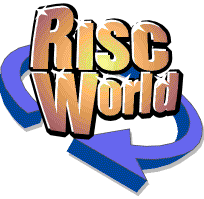



Editors Corner
Aaron Timbrells own bit of the magazine.
Phew, what a couple of months it's been. We have another cracking issue this time (in my opinion). Still, enough about RISC World it's a very exciting time at the moment. One of the most interesting things going on is the sudden interest in RISC OS programming. We have seen a number of new versions of existing applications popping up out of the woodwork. For example, a new version of Zap has just been released and it's in the software directory of this very issue. Many of these new releases are 32 bit compliant, which means of course that they will run on a 32 bit version of RISC OS, such as that found in the new Iyonix PC announced by Castle a short time before the Acorn Southeast show. For more details on the Iyonix see this issues Insider article. Castle have also released a 32 bit C compiler which seems to have kick started a new round of application development. This can only be a good thing for the market. Many of these new releases will be covered in next issue's PD column once Paul Brett has recovered from the amount of software he has been receiving! Also you can expect some very surprising announcements coming in the next issue.
We are short of a couple of regular columns this issue. Due to pressing deadlines the issue had to go to bed early (and it's been grounded and lost its pocket money too -HJ). So the Education Column and Paul Johnsons development of his football manager game will be back with us next time.
I will sign this bit off with a small warning. This is the last issue of RISC World (Hurray - HJ), wait for it, that will be on 74 minute CDs. We simply can't obtain them anymore, so RISC World will be moving to 80 minute CDs from the next issue. So if you have an old two speed CD-ROM drive, such as a Cumana, and you can't read the next RISC World then it may well be time to throw the drive away and spend £24 inclusive of VAT on a 52 speed drive and the driver software. If you don't believe that is what a CD-ROM drive costs why not check out the APDL website.
Editors Rant of the month
I only have one rant this month, my old Eizo F550i monitor. This 17" beauty was purchased from Atomwide in early 1995, but was already a couple of years old. The princely sum of £450 was handed over for a very nice, well built monitor. At first it was attached to my ancient A310 (with a ColourCard), then moved to an A5000, and then finally ended up on the main RiscPC in my office. It was used every day, sometimes for up to 18 hours at a stint. It got taken to shows all over the country. It was used while I was writing most versions of DrawWorks, in fact over 30 commercial applications, and a host of other apps, were written in front of this monitor. When I passed iSV Products over to APDL the Eizo still soldiered on, RISC World was assembled in front of it, as was the VirtualAcorn website. And then two weeks ago it started playing up. The picture went very bright, and shrunk to three quarters of its normal size. I turned the monitor off and left it to cool down. Then it was fine for a couple of days, then it did it again. Power off, wait, power on. The screen was now fine again then an hour or so later it went phut, well I say phut, more sort of tshscsczzzzzzzzz....pfhup. No picture and a nice scented burnt out monitor smell in the office. I mean this simply isn't on. I paid £450 for a monitor that only lasted seven and a half years (or 390 weeks). Ok it wasn't used all the time, but lets say it was on 8 hours a day for 5 days of the week, that would be 40 hours a week. So in total it was probably used for 15,600 hours. Since it cost £450 in the first place it therefore cost 2 pence per hour. If we assume 2p per hour for the next monitor then it will have to last 2 years, which is why paying £85 for a branded 21" monitor with a guarantee isn't too bad an idea. Actually come to think of it what am I ranting about?
Printing RISC World
The new look of RISC World means that when you want to print an article on your printer it will have the light yellow background. However most web browsers allow you to turn off the background images when printing. The example below shows the print dialogue box from Fresco.
As you can see the option "No Background" is ticked. If you want to print out any of the RISC World pages then make sure you have clicked a similar option in your browser.
Aaron Timbrell